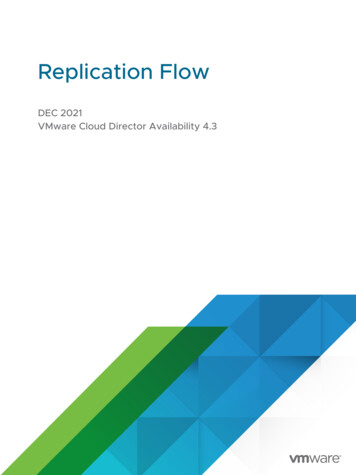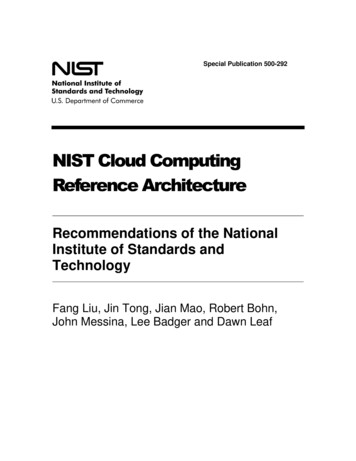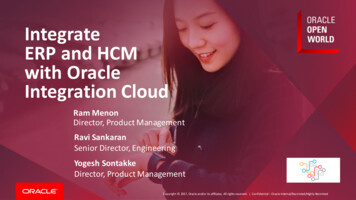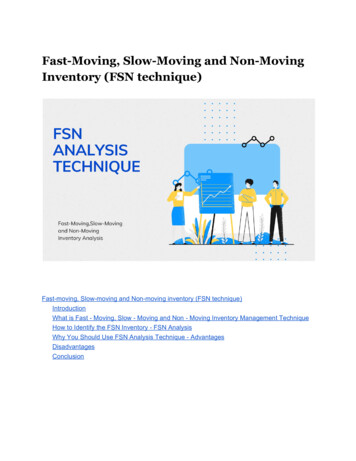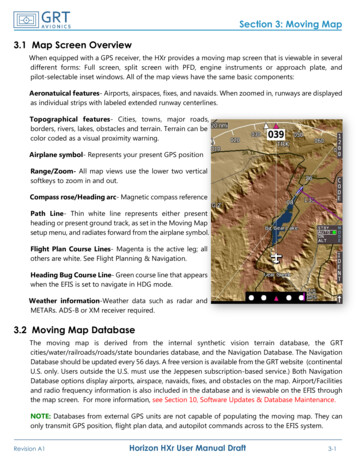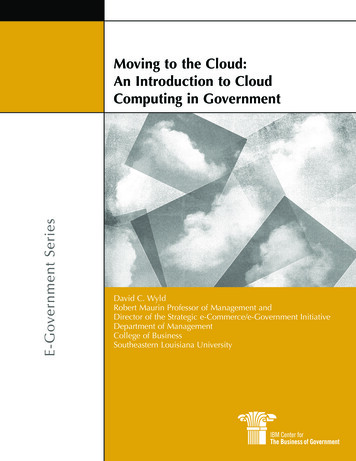
Transcription
E-Government SeriesMoving to the Cloud:An Introduction to CloudComputing in GovernmentDavid C. WyldRobert Maurin Professor of Management andDirector of the Strategic e-Commerce/e-Government InitiativeDepartment of ManagementCollege of BusinessSoutheastern Louisiana University
2009E - G ov e r n m e n t S e r i esMoving to the Cloud:An Introduction to CloudComputing in GovernmentDavid C. WyldRobert Maurin Professor of Management andDirector of the Strategic e-Commerce/e-GovernmentInitiativeDepartment of ManagementCollege of BusinessSoutheastern Louisiana University
T A B L EO FC ONT E NT SForeword.4Executive Summary.6An Introduction to Cloud Computing.9Cloud Computing 101.9Understanding Cloud Computing .13Using Cloud Computing . .14The Evolution from Grid Computing to Cloud Computing.15Cloud Computing in Government . .18The State of Cloud Computing in Government .18The Cloud and Federal IT Spending . .19The Use of Cloud Computing in Government .22Major Challenges Facing Government in Implementing CloudComputing.33Challenge One: The Need for Scalability . .33Challenge Two: The Need for High Reliability .35Challenge Three: The Need for Securing Data in the Cloud.36Challenge Four: The Need for Open Standards andInteroperability.38Challenge Five: The Need to Revise Procurement Practices . .40Challenge Six: The Need to Resolve Potential Legal Issues .42Challenge Seven: The Need to Regulate the ‘Cloud Market’.44Challenge Eight: The Need to Redefine the Roles of the ITWorkforce .45Challenge Nine: The Need to Assess the Return on Investmentof Cloud Computing . .47Challenge Ten: The Need for Government Cloud Coordination.48Looking Ahead: The Future of Cloud Computing in Government.49The Road Ahead.49Cloud Migration Strategy .52Conclusion .54Appendix: Computing—The Fifth Utility? . .56References.61About the Author.78Key Contact Information.793
Moving to the Cloud: An Introduction to Cloud Computing in GovernmentF o r ew o r dOn behalf of the IBM Center for the Business of Government, we are pleasedto present this report, “Moving to the Cloud: An Introduction to CloudComputing in Government,” by David C. Wyld.The term “cloud computing” is suddenly everywhere, with government leaders, industry executives, and the press all talking excitedly about this newconcept. In this report, Dr. Wyld examines both the interest in and the technology surrounding cloud computing, and why it is receiving such increasedattention. The report describes the incremental steps in the evolution of computer systems which enabled cloud computing to emerge. It also examines thecurrent buzz surrounding cloud computing which is increasing our expectationsof the role of information technology (IT) in government. Whereas managershave traditionally viewed IT as difficult and expensive, the promise of cloudcomputing leads many to think that IT will now be easy and cheap, perhapseven free. There are some expectations now that IT should be available ondemand, preconfigured, and ready to use, no longer requiring careful planningand integration as in the past.The reality is that, while cloud computing has simplified some technicalaspects of building computer systems, the myriad challenges facing IT executives in government will remain. This report describes many of these challenges. They include government’s current one-year budget cycle, the needfor IT security, and the need to ensure the development of accurate requirements documentation. There is also still a need for Congress to make it easierfor agencies to collaborate on cross-agency initiatives. Cloud computing alsoraises some new issues around IT security, questions such as the use of information obtained from the scanning of e-mail.What will be the impact of cloud computing? How can cloud computingdeliver on its promise if it can’t overcome the challenges discussed above?IBM’s recently released 2009 Global Chief Information Officer (CIO) Studysheds some light on this question. The survey found that CIOs add value totheir organization through innovation and aligning IT with their organization’smission. Yet, CIOs report spending over 40 percent of their time and 60 percentof their budgets on delivering routine services to their organizations. Theseroutine services are what cloud computing can deliver cheaply and easily.4IBM Center for The Business of GovernmentJonathan D. BreulJeffrey W. Koch
Moving to the Cloud: An Introduction to Cloud Computing in GovernmentThe Study leads to the conclusion that cloud computing has the potentialto transform IT, not necessarily through its impact on an agency’s corebusiness systems, but through commoditizing routine services such ase-mail, web servers, and data storage. Cloud computing can also easilydeliver services that are common across government, such as accounting,procurement, and collaboration tools. If CIOs can increase their relianceon commodity computing, they will then have more time and resources tofocus on the strategic management of IT and provide leadership and valuefor their agencies.We hope that this timely and informative report will be useful to professionals and executives across government who are seeking innovativeapproaches in order to leverage the new technology of cloud computing intheir effort to reform and improve IT programs and the delivery of servicesto both government itself and to citizens.Jonathan D. BreulExecutive DirectorIBM Center for The Business of Governmentjonathan.d.breul@us.ibm.comJeffrey W. KochAssociate PartnerIBM Global Business nt.org5
Moving to the Cloud: An Introduction to Cloud Computing in GovernmentE x ecu t i v eS u m m a r yWhat Is Cloud Computing?Cloud computing is an emerging concept. It hasmany names, including: grid computing, utilitycomputing, and on-demand computing. Indeed, oneof the hindrances to the development and adoptionof cloud computing is the lack of understanding ofwhat it is—and isn’t—among both private and public sector leaders.The term “cloud computing” has at its core a singleelement: computing services are delivered over theInternet, on demand, from a remote location, ratherthan residing on one’s own desktop, laptop, mobiledevice, or even on an organization’s servers. For anorganization, this would mean that, for a set or variable, usage-based fee—or even possibly for free—itwould contract with a provider to deliver applications, computing power, and storage viathe web.In a nutshell, the basic idea of cloud computing isthat computing will become location- and deviceindependent—meaning that it increasingly will notmatter where information is housed nor where computation/processing is taking place. This enablescomputing tasks and information to be availableanytime, anywhere from any device—so long asthere is access to the Internet. The cloud conceptalso means that, for individuals and organizationsalike, computing will increasingly be viewed as aninfinite, not a finite, resource. This is because computing is taking on an on-demand, scalable form, asadditional network bandwidth, storage, and computation capacity can be added as needed, much aspeople simply use—and pay for—more (or less)electricity as their energy needs change. For this reason, many—even in the industry—refer to this as theutility model of computing.6IBM Center for The Business of GovernmentIf industry analysts are correct, we are at an inflectionpoint—a true paradigm change—in the evolution ofcomputing. The history of computing consists of aseries of such shifts, from the era of the mainframeto the advent of the personal computer (and now, tomobile devices and netbooks), from the client-servermodel to the networked model, and from the age ofisolation to the age of the Internet. While there aremany uncertainties regarding the speed and ultimatereach of cloud computing, one thing that does appearvery certain is that “business as usual” is soon goingto be very different in our work and personal livesbecause of the advent of cloud computing.What Are the Benefits ofCloud Computing?Cloud computing offers a number of benefits,including the potential for: Rapid scalability and deployment capabilities(providing just-in-time computing power andinfrastructure) Decreased maintenance/upgrades Improved resource utilization—elasticity,flexibility, efficiencies Improved economies of scale Improved collaboration capabilities Ability to engage in usage-based pricing, making computing a variable expense, rather than afixed capital cost with high overhead Reduced information technology (IT) infrastructure needs—both up-front and support costs Capacity for on-demand infrastructure andcomputational power
Moving to the Cloud: An Introduction to Cloud Computing in Government Green-friendly—reduced environmentalfootprintImproved disaster recovery capabilitiesAll in government IT—and in government itself—need to be aware of cloud computing and considerthe possibilities it holds along with the people, technology, procurement, and governance issues raisedby its advent. Cloud computing undoubtedlychanges how we individually and collectively willapproach IT. We already use aspects of cloud computing in our personal lives, and we are migrating tothe cloud model in our work lives. The shift to cloudcomputing will also change how perhaps billions ofdollars of IT spending are directed.The challenge, as the chief information officer (CIO)of the United States, Vivek Kundra, has framed it, isto have the government IT work as well as IT doesfor ourselves in our own personal lives.How Is This Report Organized?Ten Predictions for the Cloud-EnabledFuture of Government1.Cloud computing will take off at the local andstate levels through mostly rogue, “under theradar” initiatives over the next few years.2.At the federal level, there will be a coordinated move to cloud computing, but withinevitable tension between agencies.3.There will be two to three incidents a yearworldwide with potentially massive securitybreaches, involving much media attention andattendant calls for greater regulation and oversight of cloud providers.4.There will be much cooperation between private sector firms (seeking to be cloud serviceproviders) and government agencies, with farmore data and applications than expectedtoday transitioning to the cloud over the nextdecade.5.Budget pressures will continue to drive moreand more government IT to hybrid and evenpublic clouds, as more and more formerinternal IT functions—and assets (hardware,software, data, and support personnel)—areoutsourced, with billions in procurement dollars shifting to the cloud.6.There will be greater use of cloud computing,in everything from health care and educationto the military and national security.7.Free cloud offerings—even beyond the e-mail,storage, and application functions foundtoday—will be a significant part of IT portfoliosin most governmental agencies.8.The spillover effect of government use of cloudcomputing will include faster agreementsamong major cloud providers on standardsand cloud interoperability protocols.9.There will be significant legal action arisingout of governmental uses of cloud computing,and legislation addressing both IT and businessneeds and consumer fears and protections willbe a major focus over the next decade.This report provides the reader with an introductionto what cloud computing is and how it can—andis—being used by government.Overview. The first section of this report provides anoverview of cloud computing. It begins with a lookat how cloud computing has rapidly evolved, examining what cloud computing is and is not, and seeing how the cloud has quickly taken hold as part ofour everyday lives and how it is poised to become amajor part of IT strategies for all organizations. Weexamine the notion of computing being “on demand,”following in line with other services, such as electricity and telephony, which have become utilities.We see how leadership—from the top, as with newfederal CIO Kundra, and from the bottom, from rankand-file employees, is creating real momentum forimplementing cloud computing in the public sector.Case Studies. The second section of the report looksat specific case studies of how cloud computing isbeing used presently across the public sector. Wefocus on developments across several agencies,including cloud projects and initiatives taking placewithin the General Services Administration, NASA,and the Department of Defense. We also look atinteresting ways cloud storage and services arebeginning to be used in the education sphere,10. The “democratization of technology” broughtabout by cloud computing will impact thequality of our individual online lives, thegrowth of businesses, and the pace of innovation, benefiting us all.www.businessofgovernment.org7
Moving to the Cloud: An Introduction to Cloud Computing in Governmentincluding work being done in post-secondary (colleges and universities) and primary and secondary(K-12) schools. Cloud computing efforts internationally are also discussed. Specific focus is given to theambitious project of the Japanese government, the socalled “Kasumigaseki Cloud,” and the “G-Cloud” andthe Digital Britain project in the United Kingdom.Challenges Facing Government Leaders. In the thirdsection of the report, we look at how cloud computing will impact the public sector. We examine the10 challenges facing government leaders as theywork to integrate cloud computing offerings intotheir IT strategies. These include: Challenge One: The Need for Scalability Challenge Two: The Need for High Reliability Challenge Three: The Need for Securing Data inthe Cloud Challenge Four: The Need for Open Standardsand Interoperability Challenge Five: The Need to ReviseProcurement Practices Challenge Six: The Need to Resolve PotentialLegal Issues Challenge Seven: The Need to Regulate the“Cloud Market” Challenge Eight: The Need to Redefine theRoles of the IT Workforce Challenge Nine: The Need to Assess the Returnon Investment of Cloud Computing Challenge Ten: The Need for Government CloudCoordinationSteps Government Leaders Should Take. The finalsection of the report concludes with a look at theprospects for cloud computing’s development at thefederal and state/local levels, as well as abroad. Itoffers a “cloud migration strategy” for leaders ingovernment IT to follow, which involves: Step 1: Learning. Both the “techies” and the“non-techies” in policymaking positions need tolearn about cloud computing and the potentialit holds. 8Step 2: Organizational Assessment. Conduct anexamination of the organization’s real IT utilization and how cloud-based storage, applications,IBM Center for The Business of Governmentand processing power might replace or supplement present IT capacity. Step 3: Cloud Pilot. Use one project—perhapson the edge of the organization—to test howcloud works for your agency and with yourexisting technology and people. Step 4: Cloud-Readiness Assessment. Determinewhere cloud can—and cannot—be used as partof your organization’s overall IT portfolio. Step 5: Cloud Rollout Strategy. Integrate cloudofferings as part of the agency’s overall IT strategy and work to gain buy-in to the change effortthroughout the organization. Step 6: Continuous Cloud Improvement. Cloudresources become part of the everyday workingsof the agency, and as they do, this will necessitate making decisions as to when and how tobest make use of cloud storage and applications.Many believe cloud computing represents a new erain computing. The cloud model is quickly changinghow all of us interact with computing resources andhow computing power will be procured and managed. This report addresses the use, challenges, risks,and prospects for cloud computing in government.
Moving to the Cloud: An Introduction to Cloud Computing in GovernmentAn Introduction toCloud Computing“As we look forward at government in 2020, we have to fundamentally rethink how technology can be used.”– Vivek Kundra, Federal CIO (quoted in Campbell, 2009)Cloud Computing 101Cloud computing has certainly taken on the aura ofthe “phrase du jour” (Knorr and Gruman, 2008). It iscertainly even more confusing and fluid due to thefact that it has become a “perfect marketing buzzword” (Wayner, 2008), or as Weiss (2007) labeledit—“a buzzword almost designed to be vague” (p.25). Even if unintentional, the broad cloud computing “brand” has been lauded by marketing expertsfor its simplicity and user appeal, in stark contrast tothe acronyms and jargon that characterize much ofcomputing. As Michael Litchfield, who is the creative director at Omnicom Group’s technology andfinancial arm, Doremus, recently observed in theWall Street Journal: “What took them [the information technology (IT) industry] so long? Cloud-basedservices seem much easier to grasp than ‘ApplicationService Provision.’ ASP—who came up with that?The cloud is accessible. It may, in fact, be brilliant”(quoted in Fowler and Worthen, 2009). ASPs arevendors that provide software services that arehosted on their premises for use by client companies.There is vast disagreement over what cloud computing is—and isn’t. Indeed, as Baig (2009) accuratelyassessed, it is “many things to many people” (p. 4).As of late 2008, one academic study identified atleast 22 definitions of cloud computing in commonuse (Vaquero, et al., 2008). The only real point ofagreement today is that cloud computing representsanything beyond traditional computing using one’sown data center (D’Auria and Nash, 2009) (see ASampling of Cloud Computing Definitions, p. 10).Haff (2009) shares the sentiments of many in thefield when he suggests that there will likely neverbe a “canonical definition,” for cloud computing,due to the simple fact that there are “too many people (that) have too many different perspectives.” Andthis is complicated by the fact that, as R. Miller(2008a) pointed out, “buzz-chasing marketers’ willingness to sprinkle ‘cloud dust’ over an even broaderset of technologies and services.” And the definitionof cloud computing is indeed likely to evolve overtime, as more and different applications shift to thecloud—with more and more companies seeking toprovide cloud services and technologies (Hartig,2009). The lack of a clear definition must be sharedby enthusiastic IT buyers and not just the sellers ofcloud-based services, for as Bowyer (2009) pointedout, many IT purchasers are willing to “jump on thebandwagon,” even if they are unsure precisely whatthe bandwagon is that they are joining.R. Miller (2008b) expressed his concern that thisclash of terminologies can prove extremely confusing and off-putting to potential buyers of cloud services. And the cloud movement is certainly notwithout its share of skeptics and detractors (see TheAnti-Cloud Party, p. 11).The National Institute of Standards and Technology(NIST) has stepped into the fray, seeking to find acommon-ground definition for the cloud computingconcept [see The National Institute of Standards andTechnology (NIST) Definition of Cloud Computing,p. 12]. The NIST definition has been judged to bewww.businessofgovernment.org9
Moving to the Cloud: An Introduction to Cloud Computing in GovernmentA Sampling of Cloud Computing DefinitionsAuthor/OrganizationDefinitionThe Open Cloud ManifestoConsortiumThe ability to scale and provision computing power dynamically in a costefficient way and the ability of the consumer (end user, organization, or ITstaff) to make the most of that power without having to manage the underlyingcomplexity of the technology (OpenCloudManifesto.org, 2009, p.2).The University of California,Berkeley Reliable AdaptiveDistributed Systems LaboratoryCloud Computing refers to both the applications delivered as services overthe Internet and the hardware and systems software in the Data Centers thatprovide those services. The services themselves have long been referred to asSoftware as a Service (SaaS), so we use that term. The Data Center hardwareand software is what we call a Cloud (Armbrust, et al., 2009).GartnerA style of computing where massively scalable IT-related capabilities areprovided “as a service” using Internet technologies to connect multipleexternal customers (Gartner, 2008).Michael BrownA data-processing infrastructure in which the application software—andoften the data itself—is stored permanently not on your PC but rather aremote server that’s connected to the Internet (Brown, 2009).Jaeger, Lin, Grimes, andSimmonsAn emerging model of computing where machines in large data centers canbe dynamically provisioned, configured, and reconfigured to deliver servicesin a scalable manner, for needs ranging from scientific research to videosharing to e–mail (Jaeger, et al., 2009).one of the best working definitions offered, to date,for the cloud computing concept (Hoover, 2009b). Itis especially valuable in that it defines not just thecloud computing concept overall, but spells out theessential characteristics of cloud computing and thevarious forms it can take in terms of both deliveryand deployment models. From the perspective ofNIST’s Peter Mell, the NIST definition is important inthat it is unbiased and expansive. He stated, “Weattempted to put our hands around the entire industry doing cloud computing, so we didn’t have thebias that any vendor did in their own products.We’re scientists, and we weren’t content with fuzzydefinitions that encompassed anything and everything. We took a taxonomical approach to it thatwas not always common in definitions, but enabledpeople to think about cloud computing in a waythat got a lot of traction” (quoted in Hoover, 2009b).In this report, we will use the NIST definition.There are eight fundamental elements that are vitalto enabling the cloud concept to not just exist, butto grow to its fullest potential (see Figure 1). Fromthe perspective of Rayport and Heyward (2009,p. 4), it is essential to have the following conditionsin the cloud environment: Universal connectivity—users must have nearubiquitous access to the Internet.10IBM Center for The Business of Government Open access—users must have fair, nondiscriminatory access to the Internet. Reliability—the cloud must function at levelsequal to or better than current stand-alonesystems. Interoperability and user choice—users mustbe able to move among cloud platforms. Security—users’ data must be safe. Privacy—users’ rights to their data must beclearly defined and protected. Economic value—the cloud must deliver tangible savings and benefits. Sustainability—the cloud must raise energyefficiency and reduce ecological impact.Cloud computing is still an emerging model, andthus, the real challenge, from the perspective ofMichael Heath, a professor of computer science atthe University of Illinois, is in “making this marriageof substantial processing power, computing resources,and data resources work efficiently, seamlessly, andtransparently” (quoted in Borland, 2008).Why cloud—and why now? According to the resultsof the 2009 Cloud Computing Survey, surveying
Moving to the Cloud: An Introduction to Cloud Computing in GovernmentThe Anti-Cloud PartyThe whole notion of cloud computing is not without its critics and detractors. Richard Stallman, thecreator of the GNU computer operating systemand founder of the Free Software Foundation, hascautioned that the entire cloud concept is “a trap”for both individuals and organizations alike, asthey will increasingly find themselves paying moreand more for cloud computing resources over timeas they are locked into these proprietary systems.Stallman labeled cloud computing saying, “It’s stupidity. It’s worse than stupidity: it’s a marketing hypecampaign” (quoted in Johnson, 2008).Oracle CEO Larry Ellison famously expressed hisfrustration with the expansiveness of the cloudconcept, stating: “The interesting thing about cloudcomputing is that we’ve redefined cloud computing to include everything that we already do. Thecomputer industry is the only industry that is morefashion-driven than women’s fashion. Maybe I’man idiot, but I have no idea what anyone is talking about. What is it? It’s complete gibberish. It’sinsane. When is this idiocy going to stop?” (quotedin Johnson, 2008)over 500 IT decision makers, the shift to cloudcomputing can be seen as organizations are increasingly “turning to new technologies to cut costs,rather than cutting back on their technology uptake”(Kelton Research, 2009, p. 1). Cloud computing isalso by no means an “all or nothing” proposition.Indeed, it has been seen in practice that cloudinvolvement often starts when organizations initiallyuse cloud resources for part of their non-missioncritical applications or as resources for test projects(Schwan, 2009).The cloud model presents three new dimensions forcomputing: The illusion of infinite computing resourcesavailable on demand, thereby eliminating theneed for cloud computing users to plan farahead for provisioning (“provisioning” is a termused in the cloud computing community tomean procuring capacity on demand). The elimination of an up-front commitment bycloud users, thereby allowing companies to startsmall and increase hardware resources onlywhen there is an increase in their needs.Figure 1: The 8 Fundamental Elements of Cloud rabilityandUser ChoicePrivacySecuritySource: Based on Rayport and Heyward (2009, p. 4).www.businessofgovernment.org11
Moving to the Cloud: An Introduction to Cloud Computing in GovernmentThe National Institute of Standards and Technology (NIST)Definition of Cloud ComputingIn mid-2009, NIST offered the following definition of thecloud concept: Cloud computing is a model for enablingconvenient, on-demand network access to a shared poolof configurable computing resources (e.g., networks, servers, storage, applications, and services) that can be rapidlyprovisioned and released with minimal management effortor service provider interaction. This cloud model promotesavailability and is composed of five essential characteristics, three delivery models, and four deployment models.Essential CharacteristicsOn-demand self-service. A consumer can unilaterallyprovision computing capabilities, such as server time andnetwork storage, as needed automatically without requiring human interaction with each service’s provider.Ubiquitous network access. Capabilities are availableover the network and accessed through standard mechanisms that promote use by heterogeneous thin or thick client platforms (e.g., mobile phones, laptops, and PDAs).Location-independent resource pooling. The provider’scomputing resources are pooled to serve all consumersusing a multitenant model, with different physical andvirtual resources dynamically assigned and reassignedaccording to consumer demand. The customer generallyhas no control or knowledge over the exact location of theprovided resources but may be able to specify location ata higher level of abstraction (e.g., country, state, or datacenter). Examples of resources include storage, processing,memory, network bandwidth, and virtual machines.Rapid elasticity. Capabilities can be rapidly and elastically provisioned to quickly scale up, and rapidly releasedto quickly scale down. To the consumer, the capabilitiesavailable for provisioning often appear to be infinite andcan be purchased in any quantity at any time.Measured service. Cloud systems automatically controland optimize resource use by leveraging a meteringcapability at some level of abstraction appropriate to thetype of service (e.g., storage, processing, bandwidth, andactive user accounts). Resource usage can be monitored,controlled, and reported providing transparency of the utilized service for both the provider and consumer.Cloud Delivery ModelsSoftware as a Service (SaaS). The capability provided tothe consumer is the use of the provider’s applicationsrunning on a cloud infrastructure and accessible fromSource: Mell and Grance (2009).12IBM Center for The Business of Governmentvarious client devices through a thin-client interface suchas a web browser (e.g., web-based e-mail). The consumerdoes not manage or control the underlying cloud infrastructure, network, servers, operating systems, storage, oreven individual application capabilities, with the possibleexception of limited user-specific application configuration settings.Platform as a Service (PaaS). The capability provided tothe consumer is deployment onto the cloud i
4 iBm Center for the Business of Government movinG to tHE CLoUD: An introDUCtion to CLoUD ComPUtinG in GovErnmEnt ForEWorD Jonathan D. Breul Jeffrey W. Koch on behalf of the iBm Center for the Business of Government, we are pleased to present this report, "moving to the Cloud: An introduction to Cloud Computing in Government," by David C. Wyld.





